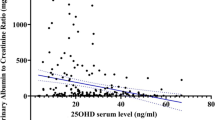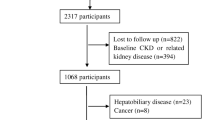Abstract
Objective
Patients with chronic kidney disease have a very high prevalence of deficiency of 25-hydroxyvitamin D [25(OH)D]. We evaluate the association between 25(OH)D and diabetic nephropathy (DN) in a Chinese sample with type 2 diabetes mellitus.
Method
The subjects were patients with diabetes mellitus who were hospitalized at our hospital during the period from June 2012 to July 2014. Serum levels of 25(OH)D were tested at admission. DN was defined as a urinary albumin-to-creatinine ratio ≥30 mg/g in a random spot urine sample. Multivariate analyses were performed using logistic regression models.
Results
We found that serum 25(OH)D levels were significantly lower in diabetes with DN as compared to without DN [8.5 (IQR 6.8–11.3) vs. 13.9 (IQR 11.2–18.2) ng/ml, P < 0.0001]. Based on the ROC curve, the optimal cutoff value of serum 25(OH)D levels as an indicator for diagnosis of DN was projected to be 10.5 ng/ml, which yielded a sensitivity of 82.6 % and a specificity of 72.7 %, with the area under the curve at 0.807 [95 % confidence interval (CI) 0.764–0.849]. Multivariate logistic regression analysis adjusted for common risk factors showed that with serum 25(OH)D level ≤10.5 ng/ml was an independent indicator of DN [odds ratio (OR) = 6.559; 95 % CI 2.864–11.368].
Conclusions
Our findings suggested that diabetes with DN had lower serum 25(OH)D levels and that determination of 25(OH)D statuses might be used to identify patients at increased risk of developing nephropathy complications.



Similar content being viewed by others
Abbreviations
- OR:
-
Odds ratio
- CI:
-
Confidence interval
References
Man X, Zhang H, Yu H et al (2015) Increased serum mannose binding lectin levels are associated with diabetic retinopathy. J Diabetes Complicat 29(1):55–58
Ritz E, Rychlik I, Locatelli F et al (1999) End-stage renal failure in type 2 diabetes: a medical catastrophe of worldwide dimensions. Am J Kidney Dis 34:795–808
Cooper ME (1998) Pathogenesis, prevention, and treatment of diabetic nephropathy. Lancet 352:213–219
Zhang Z, Sun L, Wang Y et al (2007) Renoprotective role of the vitamin D receptor in diabetic nephropathy. Kidney Int 73(2):163–171
Li YC (2008) Vitamin D and diabetic nephropathy. Curr DiabRep 8(6):464–469
Fernández-Juárez G, Luño J, Barrio V et al (2013) 25 (OH) vitamin D levels and renal disease progression in patients with type 2 diabetic nephropathy and blockade of the renin-angiotensin system. Clin J Am Soc Nephrol 8(11):1870–1876
Ulutas O, Taskapan H, Taskapan MC et al (2013) Vitamin D deficiency, insulin resistance, serum adipokine, and leptin levels in peritoneal dialysis patients. Int Urol Nephrol 45:879–884
Sarathy H, Pramanik V, Kahn J et al (2015) The effects of short-term vitamin D supplementation on glucose metabolism in dialysis patients: a systematic review and meta-analysis. Int Urol Nephrol 47(3):537–549
de Boer IH, Ioannou GN, Kestenbaum B, Brunzell JD, Weiss NS (2007) 25-Hydroxyvitamin D levels and albuminuria in the Third National Health and Nutrition Examination Survey (NHANES III). Am J Kidney Dis 50:69–77
Association AmericanDiabetes (2010) Diagnosis and classification of diabetes mellitus. Diabetes Care 33(suppl 1):S62–S69
Molitch ME, DeFronzo FA, Franz MJ et al (2004) Nephropathy in diabetes. Diabetes Care 27(Suppl 1):S79–S83
Holick MF (2007) Vitamin D deficiency. N Engl J Med 357:266–281
Reutens AT, Atkins RC (2011) Epidemiology of diabetic nephropathy. Contrib Nephrol 170:1–7
Sone H, Tanaka S, Suzuki S et al (2013) Leisure-time physical activity is a significant predictor of stroke and total mortality in Japanese patients with type 2 diabetes: analysis from the Japan Diabetes Complications Study (JDCS). Diabetologia 56:1021–1030
de Boer IH, Ioannou GN, Kestenbaum B et al (2007) 25-Hydroxyvitamin D levels and albuminuria in the Third National Health and Nutrition Examination Survey (NHANES III). Am J Kidney Dis 50(1):69–77
Lu L, Yu Z, Pan A et al (2009) Plasma 25-hydroxyvitamin D concentration and metabolic syndrome among middle-aged and elderly Chinese individuals. Diabetes Care 32:1278–1283
Zhao J, Xia W, Nie M et al (2011) The levels of bone turnover markers in Chinese postmenopausal women: peking vertebral fracture study. Menopause 18:1237–1243
Melamed ML, Astor B, Michos ED et al (2009) 25-Hydroxyvitamin D levels, race, and the progression of kidney disease. J Am Soc Nephrol 20(12):2631–2639
Wang AYM, Lam CWK, Sanderson JE et al (2008) Serum 25-hydroxyvitamin D status and cardiovascular outcomes in chronic peritoneal dialysis patients: a 3-y prospective cohort study. Am J Clin Nutr 87(6):1631–1638
Nakagawa T, Tanabe K, Croker BP et al (2010) Endothelial dysfunction as a potential contributor in diabetic nephropathy. Nat Rev Nephrol 7(1):36–44
Li YC, Qiao G, Uskokovic M et al (2004) Vitamin D: a negative endocrine regulator of the renin–angiotensin system and blood pressure. J Steroid Biochem Mol Biol 89–90:387–392
Qiao G, Kong J, Uskokovic M et al (2005) Analogs of 1alpha, 25-dihydroxyvitamin D3 as novel inhibitors of renin biosynthesis. J Steroid Biochem Mol Biol 96:59–66
Elmarakby AA, Sullivan JC (2012) Relationship between oxidative stress and inflammatory cytokines in diabetic nephropathy. Cardiovasc Ther 30:49–59
Jablonski KL, Chonchol M, Pierce GL et al (2011) 25-Hydroxyvitamin D deficiency is associated with inflammation-linked vascular endothelial dysfunction in middle-aged and older adults. Hypertension 57(1):63–69
Pan H, Zhang L, Guo M et al (2010) The oxidative stress status in diabetes mellitus and diabetic nephropathy. Acta Diabetol 47(1):71–76
Kallay E, Bareis P, Bajna E et al (2002) Vitamin D receptor activity and prevention of colonic hyperproliferation and oxidative stress. Food Chem Toxicol 40(8):1191–1196
Tu WJ, Zhao SJ, Xu DJ et al (2014) Serum 25-hydroxyvitamin D predicts the short-term outcomes of Chinese patients with acute ischaemic stroke. Clin Sci 126(5):339–346
Conflict of interest
On behalf of all authors, the corresponding author states that there is no conflict of interest.
Author information
Authors and Affiliations
Corresponding author
Rights and permissions
About this article
Cite this article
Peng, Y., Li, Lj. Serum 25-hydroxyvitamin D level and diabetic nephropathy in patients with type 2 diabetes mellitus. Int Urol Nephrol 47, 983–989 (2015). https://doi.org/10.1007/s11255-015-0983-3
Received:
Accepted:
Published:
Issue Date:
DOI: https://doi.org/10.1007/s11255-015-0983-3




